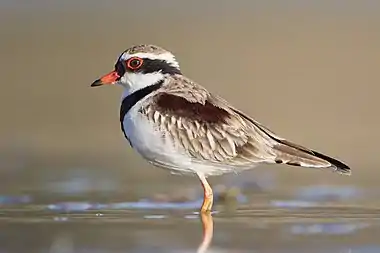| Black-fronted dotterel | |
|---|---|
 | |
| Scientific classification | |
| Domain: | Eukaryota |
| Kingdom: | Animalia |
| Phylum: | Chordata |
| Class: | Aves |
| Order: | Charadriiformes |
| Family: | Charadriidae |
| Genus: | Charadrius |
| Species: | C. melanops |
| Binomial name | |
| Charadrius melanops Vieillot, 1818 | |
The black-fronted dotterel (Charadrius melanops) is a small plover in the family Charadriidae that is found throughout much of Australia and New Zealand.
Taxonomy
The black-fronted dotterel was formally described in 1818 by the French ornithologist Louis Pierre Vieillot under the binomial name Charadrius melanops.[2] The type locality was subsequently designated as New South Wales.[3] The specific epithet combines the Ancient Greek melops meaning "black" with ōps meaning "face".[4] This species was previously placed in the monotypic genus Elseyornis but a molecular phylogenetic study published in 2022 found that it was embedded in a clade containing members of the genus Charadrius.[5] The black-fronted dotterel was therefore moved back to Charadrius. The species is monotypic: no subspecies are recognised.[6]
Description
As an adult, this small shorebird has an overall length of 16–18 cm (6.3–7.1 in), a wingspan of 33–35 cm (13–14 in) and a weight of 30–35 g (1.1–1.2 oz). The sexes are similar in appearance.[7] It has a distinct black face mask, forehead and v-shaped band across the chest. Dorsally it is a mottled brown colour with the wings and crown of the head the same colour. This colouration is particularly useful for camouflage against aerial predators. Orbital eye rings and the first section of the bill are red, with the latter being black at the tip. The legs are pale orange. Unlike many other wading birds, black-fronted dotterels retain the same plumage all year round.
Juveniles are duller in colour with a greyish beak and lacking the black breast band and forehead.[8]
Distribution and habitat
The black-fronted dotterel is widespread throughout Australia including in Tasmania and self-introduced in New Zealand where it is now also common.
It inhabits the edges of freshwater sources including wetlands, lakes, swamps, dams and billabongs, and in shallow, temporary claypan pools. Occasionally, it can also be found occupying saline mudflats and estuaries. It will avoid water more than a few mm deep and heavy vegetation. Black-fronted dotterels are typically sedentary, with a single bird, a pair, or a family group occupying a stretch of habitat on a more or less permanent basis. However, some individuals appear to travel considerable distances, and flocks will sometimes congregate in food-rich areas.
Behaviour and ecology
Food and feeding
Their diet consists of crustaceans, insects and seeds. They forage in a series of short running motions, holding the body horizontal, stopping to peck from time to time with a rapid bobbing motion.
Breeding
The black-fronted dotterel breeds between August and February, although is known to breed anytime conditions are right e.g. after suitable rains in Northern Australia. During courtship, both species will call and participate in aerial displays.
The nest is a small depression that can consist of twigs, shells and pebbles. The eggs are a greyish-yellow colour with brown and lavender markings. Incubation of the 2-3 eggs is shared between both parents. When one parent is not incubating, they still rest and feed close to the nest. During incubation, if the eggs get too hot the adults will stand over the eggs to shade them from the harsh sun or wet the feathers on their stomach to wet and cool the eggs. The egg gestation period is 4–5 weeks. Twenty-four hours after they hatch the chicks leave the nest to hide in less exposed areas, while at the same time both parents look after them. Both parents will call loudly and feign injury to lure predators away from the nest.
Gallery
 Shortly after hatching
Shortly after hatching- Tamborine, SE Queensland, Australia
 Chiltern, Victoria, Australia
Chiltern, Victoria, Australia Northern Territory, Australia
Northern Territory, Australia Atherton Tableland, Queensland, Australia
Atherton Tableland, Queensland, Australia
References
- ↑ BirdLife International (2016). "Elseyornis melanops". IUCN Red List of Threatened Species. 2016: e.T22693943A93431096. doi:10.2305/IUCN.UK.2016-3.RLTS.T22693943A93431096.en.
- ↑ Vieillot, Louis Pierre (1818). Nouveau dictionnaire d'histoire naturelle, appliquée aux arts, à l'agriculture, à l'économie rurale et domestique, à la médecine, etc (in French). Vol. 27 (Nouvelle édition ed.). Paris: Deterville. p. 139.
- ↑ Peters, James Lee, ed. (1934). Check-List of Birds of the World. Vol. 2. Cambridge, Massachusetts: Harvard University Press. p. 255.
- ↑ Jobling, James A. (2010). The Helm Dictionary of Scientific Bird Names. London: Christopher Helm. p. 247. ISBN 978-1-4081-2501-4.
- ↑ Černý, David; Natale, Rossy (2022). "Comprehensive taxon sampling and vetted fossils help clarify the time tree of shorebirds (Aves, Charadriiformes)". Molecular Phylogenetics and Evolution. 177: 107620. doi:10.1016/j.ympev.2022.107620.
- ↑ Gill, Frank; Donsker, David; Rasmussen, Pamela, eds. (December 2023). "Buttonquail, thick-knees, sheathbills, plovers, oystercatchers, stilts, painted-snipes, jacanas, Plains-wanderer, seedsnipes". IOC World Bird List Version 14.1. International Ornithologists' Union. Retrieved 30 December 2023.
- ↑ Marchant & Higgins 1993, p. 892.
- ↑ Marchant & Higgins 1993, pp. 892–893.
Sources
- Marchant, S.; Higgins, P.J., eds. (1993). "Elseyornis melanops Black-fronted plover" (PDF). Handbook of Australian, New Zealand & Antarctic Birds. Vol. 2, Raptors to lapwings. Melbourne, Victoria: Oxford University Press. pp. 892–902. ISBN 978-0-19-553069-8.
- "Black-fronted dotterel | New Zealand Birds Online".
- Geering, A., Agnew, L. and Harding, S. 2007. Shorebirds of Australia. CSIRO Publishing. 9780643101340
- Menkhorst, P., Rogers, D., Clarke, R., Davies, J. and Marsack P. 2019. The Australian bird guide. Australia, CSIRO. 9781486311934
- Pizzey, G and Knight, F. 2012. Birds of Australia. Australia. HarperCollins Publishers. 9780732291938
- Reader's Digest. 1976. Reader's Digest completebook of Australian Birds. Sydney, Reader's Digest. 0909486409
- Rowland, P and Farrell, C. 2018. Australia's birdwatching megaspots. John Beaufoy Publishing p. 229. 9781912081660
External links
 Media related to Elseyornis melanops at Wikimedia Commons
Media related to Elseyornis melanops at Wikimedia Commons Data related to Elseyornis melanops at Wikispecies
Data related to Elseyornis melanops at Wikispecies

_svg-element.svg.png.webp)

